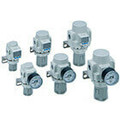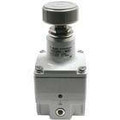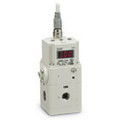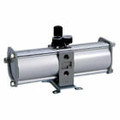Pneumatic pressure Regulators from Orange Coast Pneumatics have been updated to the new urban white base color for a clean modern look. You can monitor air pressure to either reduce or sustain the designated threshold. They have a low learning curve so that any human operator can manage your pneumatic system.
The pressure drop across the regulator has been reduced. This effect creates a more efficient unit with a maximum set pressure of 100 psi. The locking adjustment knob prevents accidental setting changes. Such an arrangement reduces the amount of human error, especially in the case of heavy industrial services.
Types Of Pressure Regulators
Generally, pressure regulators are a type of control valve. They directly regulate the amount of pressure that enters the machine pathways at certain points, and how the air molecules are sustained. As a result, they are important in the case that air is either excessive or too small to meet demand.
A pressure reducing regulator is installed upstream and focus on the input of air. These are better for sensitive environments. A pressure sustaining valve, in contrast, is usually installed to allow air into the machine. It handles downstream pressure.
The AR-A is one of our top air regulators, and one that can replace half of the AR- Special Environment series. There are five different body sizes. AR-B will replace the other half of the AR-Special Environment series.
If you would like a vacuum regulator, try the IRV series. It is designed for portability and compact, to fit into tighter systems. You can also get an adjustment resolution as an additional upgrade.
Do you need an even smaller series, for a compact system? The ARJ series fits the bill, with certain models with or without one-touch fittings. Other options include a pressure gauge and two possible mounting threads.
Options include a mounting bracket and set nuts for panel mounting as well as pressure gauges. The modular design of the AR-A series connects with other SMC air preparation equipment of similar size. Decide if you want threading, port sizes, the addition of a pressure gauge, and other standards. We’ll automatically notify you if a certain combination cannot be produced, allowing you to select an alternative.
Evaluate your temperature range for the environment and the materials that you would prefer. Stainless steel and brass are the general standards. The benefit of stainless steel is that it is long-lasting, waterproof and corrosion-resistant. A high heat threshold ensures that it can handle extreme temperatures. Brass, in contrast, has a smaller temperature range but is affordable and portable. It can be shaped into different substances.
Aluminum is a cost-effective option, if less flexible. Try to only choose plastic if you are on an extremely low budget. They are best when you want disposable regulators, and if the products are not held to high standards. You want to stay safe while controlling input and output pressures.
Industries And Devices That Use Pressure Regulators
Many pressure cookers and gas grills have pressure regulators and for a good reason. If a gas grill doesn’t have a valve that reduces the propane used, then it can lead to real hazards for the person using or anyone nearby, depending on the sparks in the air. Pressure cookers risk explosion if not monitored, and regulators assist with reducing that possibility.
You will also find these precision regulators used in doctors’ and dental offices. A good portion of anesthesia is administered by gas, and an overdose could potentially kill a patient. In contrast, if too little nitrous oxide or another sedative is used, then the person could wait up on the operating table or on the dentist’s chair, risking their health and stress level. For that reason, pressure control is more than necessary. It is a matter of life and death.




